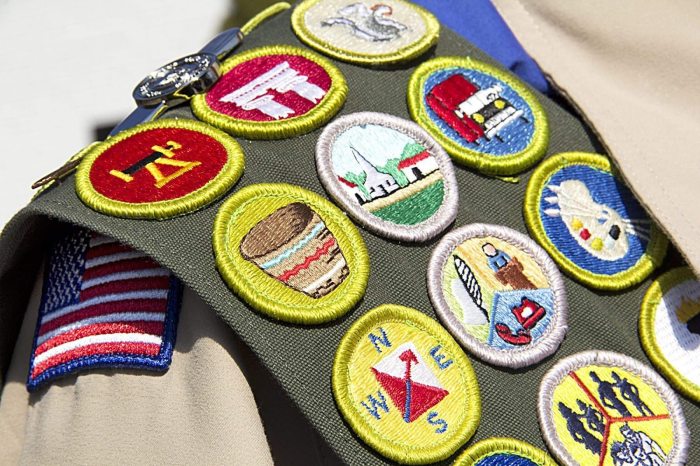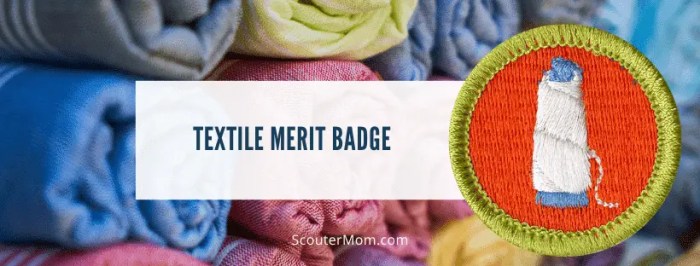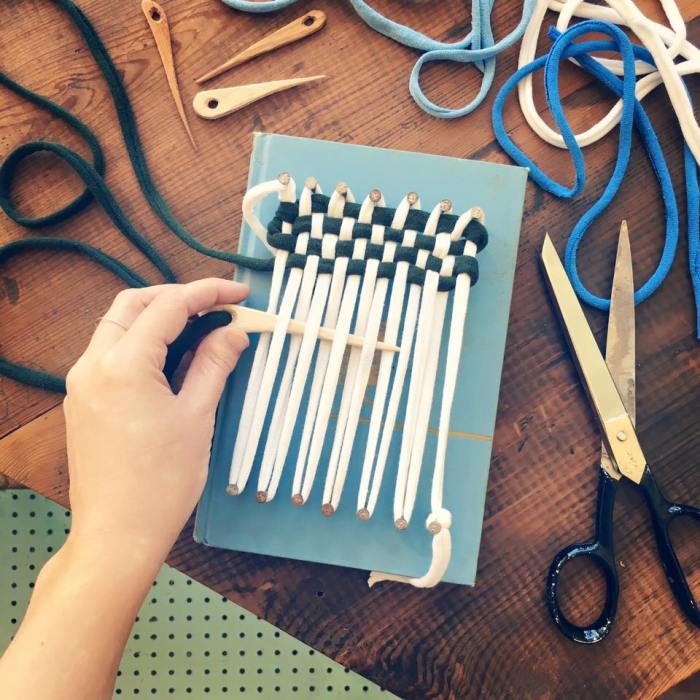Embark on a textile adventure with our comprehensive guide to Textile Merit Badge materials. Dive into the world of fabrics, sewing techniques, and textile design, unlocking the secrets to earning this prestigious badge.
From selecting the perfect fabrics to mastering basic sewing skills, this guide equips you with the knowledge and materials to create stunning textile projects that showcase your creativity and skill.
Textile Merit Badge Materials

The Textile Merit Badge, offered by the Boy Scouts of America, introduces Scouts to the world of fabrics and textiles. It aims to cultivate an appreciation for the versatility and significance of textiles in our daily lives and encourages Scouts to explore the various aspects of textile production and usage.
Materials Required
To earn the Textile Merit Badge, Scouts must demonstrate proficiency in various tasks related to textiles. This requires them to gather a comprehensive set of materials, including:
- Fabric samples of different types and textures
- Sewing machine and basic sewing supplies (needles, thread, scissors)
- Fabric dye or paint
- Embroidery floss and needles
- Fiber identification chart or microscope
Fabric Selection and Preparation

Selecting the right fabric for a textile project is crucial to ensure a successful outcome. Several factors should be considered, including the intended use, durability, and aesthetic appeal. Before sewing, it’s essential to prepare fabrics properly to enhance their workability and longevity.
Fabric Selection
- Purpose:Determine the intended use of the fabric, whether it’s for clothing, home décor, or other purposes.
- Durability:Consider the fabric’s strength, abrasion resistance, and ability to withstand wear and tear.
- Fiber Content:Choose fabrics made from fibers that suit the project’s requirements, such as natural fibers (e.g., cotton, silk) or synthetic fibers (e.g., polyester, nylon).
- Weave:The weave of the fabric (e.g., plain, twill, satin) affects its texture, drape, and durability.
- Weight:Select a fabric weight that corresponds to the intended use, ranging from lightweight for sheer fabrics to heavyweight for sturdy fabrics.
- Color and Pattern:Consider the desired color and pattern that complements the project’s overall design.
Fabric Preparation
Proper fabric preparation is essential for successful sewing. It involves:
- Pre-washing:Wash and dry the fabric to remove any shrinkage or excess dye before cutting and sewing.
- Ironing:Iron the fabric to remove wrinkles and make it easier to handle.
- Interfacing:Use interfacing to reinforce or add stability to certain areas of the fabric, such as collars or buttonholes.
Fabric Finishes
Fabric finishes can enhance the appearance, feel, or functionality of fabrics. Common finishes include:
- Sanforizing:A process that prevents shrinkage.
- Mercerizing:A process that strengthens and gives a lustrous finish to cotton fibers.
- Wrinkle-resistant:Finishes that reduce wrinkling.
- Flame-retardant:Finishes that make fabrics more resistant to fire.
- Water-repellent:Finishes that repel water and stains.
Basic Sewing Techniques

Mastering basic sewing techniques is crucial for any textile project. These techniques form the foundation for creating various textile items, from simple repairs to elaborate garments. This article will delve into the fundamental sewing techniques, including seam construction, hemming, and closure methods.
Seam Construction
Seams are the junctions where two or more pieces of fabric are joined together. There are various seam types, each with its unique purpose and strength. Common seam types include plain seams, French seams, and serged seams. The choice of seam depends on the fabric, project requirements, and desired finish.
- Plain seams are the simplest and most common seam type, suitable for most fabrics. They are created by sewing two pieces of fabric right sides together, then turning them right side out and pressing.
- French seams are stronger and more durable than plain seams. They are constructed by sewing two seams, one on each side of the fabric, then trimming the excess fabric and turning the seam inside out to enclose the raw edges.
- Serged seams are created using a serger machine, which trims and overcasts the fabric edges simultaneously. This results in a clean, professional-looking finish that is often used in garments and other delicate projects.
Textile Design and Embellishment
Textile design involves creating original patterns and embellishing fabrics to enhance their aesthetic appeal. Embellishment techniques include embroidery, applique, and other creative methods.
Principles of Textile Design
Textile design principles include balance, contrast, emphasis, proportion, and rhythm. Balance refers to the distribution of elements within a design, while contrast involves using different colors, textures, or patterns to create visual interest. Emphasis highlights certain elements of the design, proportion ensures the elements are in the right size and scale, and rhythm creates a sense of movement or flow.
Embellishment Techniques
Embroidery involves stitching designs onto fabric using thread, creating intricate patterns and textures. Applique is the technique of sewing pieces of fabric onto another fabric, forming decorative designs. Other embellishment techniques include beading, sequins, lace, and fringe.
Textile Dyes, Textile merit badge materials
Textile dyes are used to color fabrics and create patterns. Natural dyes are derived from plants, animals, or minerals, while synthetic dyes are chemically produced. The type of dye used depends on the desired color, fabric type, and desired durability.
Textile Projects for the Merit Badge
The Textile Merit Badge challenges Scouts to explore the world of textiles and develop practical skills in fabric selection, sewing, and design. To earn the badge, Scouts must complete a series of projects that demonstrate their proficiency in these areas.
The following list provides project ideas that meet the requirements for the Textile Merit Badge. Each project includes a brief explanation of the steps involved and the different types of textile crafts used.
Pillowcase or Tote Bag
This project introduces Scouts to basic sewing techniques, such as cutting fabric, sewing straight seams, and inserting a zipper. Scouts can choose to make either a pillowcase or a tote bag, depending on their interests and skill level.
- Steps:Cut the fabric, sew the side seams, insert the zipper, and sew the top and bottom edges.
- Textile crafts:Machine sewing, hand sewing, fabric cutting
Quilt Block
This project teaches Scouts about the principles of quilt making, including fabric selection, cutting, and piecing. Scouts will create a small quilt block using a variety of fabrics and patterns.
- Steps:Select fabrics, cut the fabric into squares, piece the squares together, and quilt the block.
- Textile crafts:Fabric selection, fabric cutting, piecing, quilting
Embroidered Patch
This project allows Scouts to explore the art of embroidery. Scouts will design and embroider a patch that can be used to decorate clothing or other items.
- Steps:Design the patch, transfer the design to fabric, and embroider the design.
- Textile crafts:Embroidery, fabric design, fabric decoration
Woven Wall Hanging
This project introduces Scouts to the basics of weaving. Scouts will use a simple loom to create a small wall hanging using yarn or other materials.
- Steps:Warp the loom, weave the weft threads, and remove the weaving from the loom.
- Textile crafts:Weaving, loom construction, yarn selection
Wrap-Up: Textile Merit Badge Materials

Whether you’re a seasoned textile enthusiast or just starting your journey, this guide empowers you to confidently navigate the Textile Merit Badge requirements and produce exceptional textile projects that will leave a lasting impression.
Key Questions Answered
What are the essential materials for earning the Textile Merit Badge?
The required materials include fabrics, needles, thread, scissors, measuring tape, and sewing machine.
How do I choose the right fabrics for my textile projects?
Consider factors such as fiber content, weight, drape, and intended use when selecting fabrics.
What are the basic sewing techniques I need to master?
Mastering seams, hems, and closures is crucial for successful textile projects.
